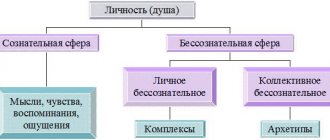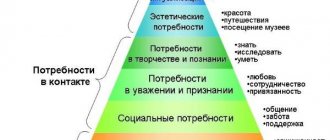Personal needs (need) are the so-called source of personal activity, because it is a person’s needs that are his motivation for acting in a certain way, forcing him to move in the right direction. Thus, need or need is a personal state in which the dependence of subjects on certain situations or conditions of existence is revealed.
Personal activity manifests itself only in the process of satisfying its needs, which are formed during the upbringing of the individual and his introduction to public culture. In its primary biological manifestation, need is nothing more than a certain state of the organism, expressing its objective need (desire) for something. Thus, the system of individual needs directly depends on the individual’s lifestyle, the interaction between the environment and the sphere of its use. From the perspective of neurophysiology, need means the formation of some kind of dominant, i.e. the appearance of excitation of special brain cells, characterized by stability and regulating required behavioral actions.
Types of personality needs
Human needs are quite diverse and today there are a huge variety of their classifications. However, in modern psychology there are two main classifications of types of needs. In the first classification, needs (needs) are divided into material (biological), spiritual (ideal) and social.
The realization of material or biological needs is associated with the individual-species existence of the individual. These include the need for food, sleep, clothing, safety, home, intimate desires. Those. need (need), which is determined by biological need.
Spiritual or ideal needs are expressed in knowledge of the world around us, the meaning of existence, self-realization and self-esteem.
The desire of an individual to belong to any social group, as well as the need for human recognition, leadership, dominance, self-affirmation, affection of others in love and respect is reflected in social needs. All these needs are divided into important types of activity:
- labor, work - the need for knowledge, creation and creation;
- development – the need for training, self-realization;
- social communication – spiritual and moral needs.
The needs or needs described above have a social orientation, and therefore are called sociogenic or social.
In another type of classification, all needs are divided into two types: need or need for growth (development) and conservation.
The need for conservation combines the following physiological needs (needs): sleep, intimate desires, hunger, etc. These are the basic needs of the individual. Without their satisfaction, the individual is simply unable to survive. Next is the need for security and preservation; abundance – comprehensive satisfaction of natural needs; material needs and biological.
The need for growth combines the following: the desire for love and respect; self-actualization; self-esteem; knowledge, including life meaning; needs for sensory (emotional) contact; social and spiritual (ideal) needs. The above classifications make it possible to highlight the more significant needs of the subject’s practical behavior.
OH. Maslow put forward the concept of a systematic approach to research into the psychology of personality subjects, based on a model of personality needs in the form of a pyramid. Hierarchy of personality needs according to A.Kh. Maslow represents the behavior of an individual that directly depends on the satisfaction of his any needs. This means that the needs at the top of the hierarchy (realization of goals, self-development) direct the individual’s behavior to the extent that his needs at the very bottom of the pyramid (thirst, hunger, intimate desires, etc.) are satisfied.
They also distinguish between potential (non-actualized) needs and actualized ones. The main driver of personal activity is the internal conflict (contradiction) between the internal conditions of existence and external ones.
All types of personal needs located at the upper levels of the hierarchy have different levels of expression in different people, but without society, not a single person can exist. A subject can become a full-fledged personality only when he satisfies his need for self-actualization.
Maslow's Hierarchy of Needs
Needs and motives have a multi-level structure. Only when the needs of the lower order are fully satisfied do more sublime ones appear. Based on this, A. Maslow proposed the following hierarchy of needs for consideration:
- Physiological needs. These are food, water, oxygen, clothing and shelter. If these needs are not satisfied, there can be no talk of any others.
- Safety. This refers to a stable situation that instills confidence in long-term survival. Most often we are talking about financial well-being.
- The need to belong. A person needs to be attached to someone. These are family, friendship and love connections.
- The need for respect. Having a solid foundation in the form of the three previous levels, a person begins to need public approval. He wants to be respected and needed.
- Self-actualization is the highest level of need. This means continuous personal and career growth.
Despite the fact that this hierarchical system is considered generally accepted, many researchers (for example, A. N. Leontyev) disagree with it. There is an opinion according to which the sequence of emergence of needs is based on the subject’s sphere of activity and his personal characteristics.
Social needs of the individual
This is a special kind of human need. It lies in the need to have everything necessary for the existence and functioning of an individual, a social group, or society as a whole. This is an internal motivating factor for activity.
Social needs are the need of people for work, social activity, culture, and spiritual life. The needs created by society are those needs that are the basis of social life. Without motivating factors to satisfy needs, production and progress in general are impossible.
Social needs also include those associated with the desire to form a family, joining various social groups, teams, various areas of production (non-production) activity, and the existence of society as a whole. Conditions and environmental factors that surround an individual in the process of his life not only contribute to the emergence of needs, but also create opportunities to satisfy them. In human life and the hierarchy of needs, social needs play one of the determining roles. The existence of an individual in society and through it is the central area of manifestation of the essence of man, the main condition for the realization of all other needs - biological and spiritual.
Social needs are classified according to three criteria: the needs of others, their own needs, and common needs.
The needs of others (needs for others) are needs that express the generic basis of the individual. It lies in the need for communication, protection of the weak. Altruism is one of the expressed needs for others, the need to sacrifice one's interests for others. Altruism is realized only through victory over egoism. That is, the need “for oneself” must be transformed into a need “for others.”
One’s own need (need for oneself) is expressed in self-affirmation in society, self-realization, self-identification, the need to take one’s place in society and the team, the desire for power, etc. Such needs are therefore social, because they cannot exist without needs “for others.” " Only through doing something for others is it possible to realize your desires. Take some position in society, i.e. It is much easier to achieve recognition for oneself without affecting the interests and claims of other members of society. The most effective way to realize your egoistic desires will be a path along which a share of compensation is contained to satisfy the claims of other people, those who can claim the same role or the same place, but can be satisfied with less.
Joint needs (needs “together with others”) - express the motivating power of many people at the same time or society as a whole. For example, the need for security, freedom, peace, a change in the existing political system, etc.
Practical advice
Motivation is needed by those who want to force a person to fulfill demands and obey. Therefore, they manage children, subordinates, consumers - buyers of goods and services. Even the desire to have a slim body is an imposed motive. To avoid needing motivation, you need:
- determine the type of activity you like;
- identify the goal that can be achieved in this activity;
- to have, as a result of achieving the goal, satisfaction of the financial and internal goals - gratitude, self-esteem, recognition of mastery.
That's when there will be no need for motivation. The purpose of the activity motivates itself.
Needs and motives of the individual
The main condition for the life of organisms is the presence of their activity. In animals, activity manifests itself in instincts. But human behavior is much more complex and is determined by the presence of two factors: regulatory and incentive, i.e. motives and needs.
The motives and system of needs of the individual have their own main characteristics. If need is need (scarcity), the need for something and the need to eliminate something that is in abundance, then the motive is a pusher. Those. need creates a state of activity, and motive gives it direction, pushes activity in the required direction. Necessity or necessity, first of all, is felt by a person as a state of tension inside, or manifests itself as thoughts, dreams. This encourages the individual to search for an item of need, but does not give direction to the activity to satisfy it.
Motive, in turn, is an incentive to achieve the desired or, conversely, to avoid it, to carry out an activity or not. Motives can be accompanied by positive or negative emotions. Satisfying needs always leads to a release of tension; the need disappears, but after a while it can arise again. With motives, the opposite is true. The stated goal and the immediate motive do not coincide. Because a goal is where or what a person strives for, and a motive is the reason why he strives.
You can set a goal for yourself following different motives. But an option is also possible in which the motive shifts to the goal. This means transforming the motive of activity directly into a motive. For example, a student initially learns his homework because his parents force him to, but then interest awakens and he begins to study for the sake of learning itself. Those. It turns out that a motive is an internal psychological motivator of behavior or actions, which is stable and encourages an individual to carry out activities, giving it meaning. And need is an internal state of feeling need, which expresses the dependence of a person or animals on certain conditions of existence.
Violations caused by unfulfilled needs
If the need, motive, interest have not been satisfied, this can lead to disturbances in the activity of the central nervous system. Sometimes a person succeeds due to self-regulation mechanisms. However, if internal resources are insufficient, the following neuropsychic disorders may occur:
- A neurasthenic conflict is a contradiction between high expectations or needs and insufficient resources to fulfill them. People who cannot adequately satisfy their drives and aspirations are predisposed to such problems. They are characterized by increased excitability, emotional instability, and depressed mood.
- Hysteria, as a rule, is associated with an inadequate assessment of oneself and others. As a rule, a person considers himself better than others. The reason may also be a contradiction between needs (for example, moral principles and forced actions). Hysteria is characterized by pain sensitivity, speech disorders and impaired motor function.
- Obsessive-compulsive neurosis occurs in those people whose needs and motives for activity are not clearly defined. Not knowing what he wants, a person becomes irritable and gets tired quickly. He may be tormented by sleep disorders, obsessions and phobias.
Needs and interests of the individual
The category of need is inextricably linked with the category of interests. The origin of interests is always based on needs. Interest is an expression of an individual’s purposeful attitude towards some type of his needs.
A person’s interest is not so much directed specifically at the subject of need, but rather directed at such social factors that make this subject more accessible, mainly the various benefits of civilization (material or spiritual), which ensure the satisfaction of such needs. Interests are also determined by the specific position of people in society, the position of social groups and are the most powerful incentives for any activity.
Interests can also be classified depending on the focus or the carrier of these interests. The first group includes social, spiritual and political interests. The second includes the interests of society as a whole, group and individual interests.
The interests of an individual express his orientation, which largely determines his path and the nature of any activity.
In its general manifestation, interest can be called the true reason for social and personal actions, events, which stands directly behind the motives of individuals taking part in these very actions. Interest can be objective and objective social, conscious, realizable.
The objectively effective and optimal way to satisfy needs is called objective interest. Such interest is of an objective nature and does not depend on the consciousness of the individual.
An objectively effective and optimal way to satisfy needs in public space is called objective social interest. For example, there are a lot of stalls and shops in the market and there is definitely an optimal path to the best and cheapest product. This will be a manifestation of objective social interest. There are many ways to make various purchases, but among them there will definitely be one that is objectively optimal for a particular situation.
The subject's ideas about how best to satisfy his needs are called conscious interest. Such interest may coincide with the objective one or be slightly different, or may have a completely opposite direction. The immediate cause of almost all actions of subjects is precisely the interest of a conscious nature. Such interest is based on a person’s personal experience. The path that a person takes to satisfy the needs of the individual is called realized interest. It can completely coincide with the interest of a conscious nature, or absolutely contradict it.
There is another type of interest - this is a product. This variety represents both the path to satisfying needs and the way to satisfy them. A product may be the optimal way to satisfy a need and may appear to be so.
Factors that determine the level of motivation
Regardless of the type of stimulus that drives a person’s activity - the motive he has, the level of motivation is not always the same and constant for a person. Much depends on the type of activity performed, the prevailing circumstances and the person’s expectations. For example, in the professional environment of psychologists, some specialists choose the most complex problems to study, while others limit themselves to “modest” problems in science, planning to achieve significant achievements in their chosen area. The factors that determine the level of motivation are the following criteria:
- the importance for the individual of the promising fact of achieving success;
- faith and hope for outstanding achievement;
- a person’s subjective assessment of the existing probability of obtaining high results;
- a person’s subjective understanding of standards and standards of success.
Spiritual needs of the individual
The spiritual needs of the individual are a directed aspiration for self-realization, expressed through creativity or through other activities.
There are 3 aspects of the term spiritual needs of the individual:
- The first aspect includes the desire to master the results of spiritual productivity. This includes exposure to art, culture, and science.
- The second aspect lies in the forms of expression of needs in the material order and social relations in current society.
- The third aspect is the harmonious development of the individual.
Any spiritual needs are represented by a person’s internal motivations for his spiritual manifestation, creativity, creation, creation of spiritual values and their consumption, for spiritual communications (communication). They are determined by the individual’s inner world, the desire to withdraw into oneself, to focus on what is not related to social and physiological needs. These needs encourage people to engage in art, religion, and culture not in order to satisfy their physiological and social needs, but in order to understand the meaning of existence. Their distinguishing feature is their insaturability. Since the more internal needs are satisfied, the more intense and stable they become.
There are no limits to the progressive growth of spiritual needs. The limitation of such growth and development can only be the amount of spiritual wealth previously accumulated by humanity, the strength of the individual’s desires to participate in their work and his capabilities. The main features that distinguish spiritual needs from material ones:
- needs of a spiritual nature arise in the consciousness of the individual;
- needs of a spiritual nature are inherently necessary, and the level of freedom in choosing ways and means to satisfy such needs is much higher than that of material ones;
- satisfaction of most spiritual needs is mainly related to the amount of free time;
- in such needs, the connection between the object of need and the subject is characterized by a certain degree of unselfishness;
- the process of satisfying spiritual needs has no boundaries.
In terms of their content, spiritual needs are objective. They are determined by the totality of the living conditions of individuals and demonstrate the objective need for their spiritual study of the social and natural world that surrounds them.
Yu. Sharov identified a detailed classification of spiritual needs: the need for work; the need for communication; aesthetic and moral needs; scientific and educational needs; need for health improvement; the need of military duty. One of the most important spiritual needs of a person is knowledge. The future of any society depends on the spiritual foundation that will be developed among modern youth.
The need for communication in different people
Photo by Ketut Subiyanto: Pexels
Children and teenagers are a category of people who have not yet reached their personal maturity. Therefore, more than adults, they have a great desire to communicate with other people. Every child likes to play and spend time with peers.
Children are always eager to make friends and identify someone special among them. It is in the process of forming such connections that a person’s healthy psyche and personality are formed. Adolescence is a special period. Therefore, a growing child who has entered this transitional period may experience problems with communication.
For the development of personality, it is important that a child has a friend. Wanting to be alone is not a sign of immaturity or problems.
Adults can already be called mature individuals. It is believed that they already know what they want to get from life. When a person has matured, his communication can be reduced to satisfying his personal needs, such as: gaining knowledge, demonstrating individuality, recognition and prestige. The main thing is not to forget about the interests and needs of the interlocutors in the process, then the communication will be productive.
Communication and nonviolent communication
Psychological needs of the individual
The psychological needs of an individual are those needs that are not limited to bodily needs, but also do not reach the level of spiritual ones. Such needs usually include the need for affiliation, communication, etc.
The need for communication in children is not an innate need. It is formed through the activity of surrounding adults. Usually it begins to actively manifest itself by two months of life. Adolescents are convinced that their need for communication brings them the opportunity to actively use adults. For adults, insufficient satisfaction of the need for communication has a detrimental effect. They become immersed in negative emotions. The need for acceptance is the desire of an individual to be accepted by another person, a group of people or society as a whole. Such a need often pushes a person to violate generally accepted norms and can lead to antisocial behavior.
Among the psychological needs, basic needs of the individual are distinguished. These are needs that, if not met, young children will not be able to fully develop. They seem to stop in their development and become more susceptible to certain diseases than their peers who have such needs met. For example, if a baby is regularly fed but grows without proper communication with his parents, his development may be delayed.
The basic personal needs of adults of a psychological nature are divided into 4 groups: autonomy - the need for independence, independence; need for competence; the need for interpersonal relationships that are significant for the individual; the need to be a member of a social group and to feel loved. This also includes a sense of self-worth and the need to be recognized by others. In cases of unsatisfaction of basic physiological needs, the physical health of the individual suffers, and in cases of unsatisfaction of basic psychological needs, the spirit (psychological health) suffers.
Factors that determine the level of motivation
The power of motivation consists of the factors that make it up:
internal motive - the need for action, development, change forms the reason for movement. The goal or desired object (result of action) - must be so significant as to influence the picture of the world, capture consciousness and attention. The possibilities of satisfying a need are sometimes much smaller than the circumstances that have to be overcome. Therefore, a sober assessment of strengths and weaknesses is important. Ability to plan – a plan does not have to be on paper, but only in your head
To perform an action, you need to have knowledge and instructions for completing it. Lack of knowledge may be the reason for low levels of motivation. Self-control and implementation of the plan depends on what you have to sacrifice to achieve the goal. Insufficient reward can disappoint - that’s why motivation always consists of internal and external factors.
Vector of effort, direction - it is important that a person is attracted to the external aspects of the process or result. It is the internal motive - the need for action, development, change that forms the reason for movement
Motivation and personality needs
The motivational processes of an individual are aimed at achieving or, conversely, avoiding set goals, implementing certain activities or not. Such processes are accompanied by various emotions, both positive and negative, for example, joy, fear. Also during such processes some psychophysiological tension appears. This means that motivational processes are accompanied by a state of excitement or agitation, and a feeling of decline or surge of strength may also appear.
On the one hand, the regulation of mental processes that affect the direction of activity and the amount of energy needed to perform this very activity is called motivation. On the other hand, motivation is still a certain set of motives that gives direction to activity and the most internal process of motivation. Motivational processes directly explain the choice between different options for action, but which have equally attractive goals. It is motivation that influences the perseverance and perseverance with which an individual achieves his goals and overcomes obstacles.
A logical explanation of the reasons for actions or behavior is called motivation. Motivation may differ from real motives or be deliberately used to disguise them.
Motivation is quite closely related to the needs and requirements of the individual, because it appears when desires (needs) or a lack of something arise. Motivation is the initial stage of an individual’s physical and mental activity. Those. it represents a certain incentive to perform actions by a certain motive or process of choosing reasons for a particular direction of activity.
It should always be taken into account that completely different reasons may lie behind completely similar, at first glance, actions or actions of a subject, i.e. Their motivation may be completely different.
Motivation can be external (extrinsic) or internal (intrinsic). The first is not related to the content of a specific activity, but is determined by external conditions relative to the subject. The second is directly related to the content of the activity process. There is also a distinction between negative and positive motivation. Motivation based on positive messages is called positive. And motivation, the basis of which is negative messages, is called negative. For example, a positive motivation would be “if I behave well, they will buy me ice cream,” a negative motivation would be “if I behave well, they will not punish me.”
Motivation can be individual, i.e. aimed at maintaining the constancy of the internal environment of one’s body. For example, avoidance of pain, thirst, desire to maintain optimal temperature, hunger, etc. It can also be a group one. This includes caring for children, searching and choosing one’s place in the social hierarchy, etc. Cognitive motivational processes include various play activities and research.
Why do you need motivation?
Who needs it?
Motivation is an instruction for behavior. When a person wants something, the brain independently finds clues to achieve success. A guy seeks a girl's attention, a child finds gifts from Santa Claus, a woman loses weight after giving birth. They are motivated because they know exactly what they want. The search for motivation is carried out by those who are not sure of the goal. A person who gets paid to work for survival will crawl to work. His ego will scream that it is better to sleep, but to sleep he will want to eat, and food is bought with money. And again we need to work! Motivation is a struggle against one’s own habits and foundations. Therefore, trainers and motivators warn - get ready to change your life completely. Trying on someone else’s experience is being motivated by someone else’s success. This reveals the line between how external and internal motivation works - the difference between an imposed goal and determination.
List of used literature
List of used literature
1. Averin V.A. Personality psychology: Textbook. – St. Petersburg: V.A. Mikhailov Publishing House, 2013. – P. 79.
2. Aleksandrova Yu.V. Fundamentals of general psychology. Edited by Borodin A.V. – NOU, 2014. – P.85-88.
3. Vygotsky L.S. Psychology of human development. – M.: Publishing House Meaning; Eksmo Publishing House, 2015. –P.136.
4. Ilyin E.P. Motivation and motives. – St. Petersburg: Peter, 2014. – P.52-60.
5. Nemov R.S. Psychology: Dictionary-reference book. At 2 hours - M.: Publishing house VLADOS-PRESS, 203. - Part 2. - P. 152.
6. Frager R., Fadiman D. Theories of personality and personal growth. – St. Petersburg: Peter, 2014. – P.67.
7. Kjell L., Ziegler D. Theories of personality. – St. Petersburg: Peter, 2013. – P. 107.
8. Dictionary of psychological terms. - [Electronic resource].
– Access mode: https://www.persev.ru/ (date of access: 10/20/2016).
9. Library of educational and scientific literature. Ilyin.E.P. Motivation and motives. – 2013. – [Electronic resource].
– Access mode: https://sbiblio.com (date of access: 10/20/2016).
10. Golovin. S.Yu. Dictionary of a practical psychologist. – 2014. – [Electronic resource].
– Access mode: https://bookmate.com (date of access: 10/20/2016).









